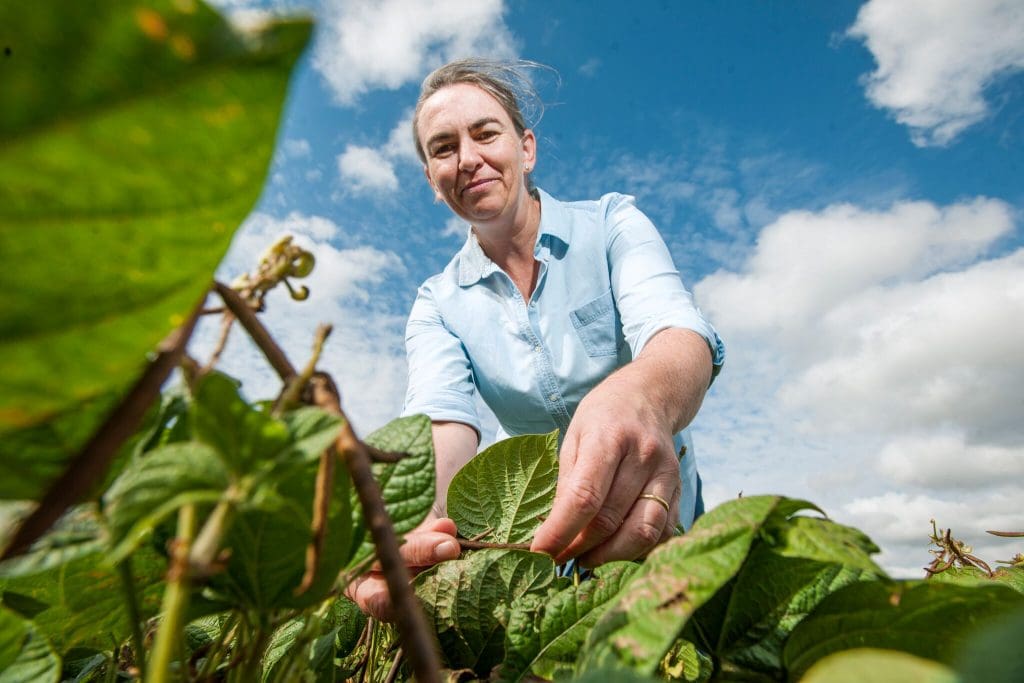GRAIN growers looking to limit the effect of the root-lesion nematode, Pratylenchus thornei, are advised to consider the impact of including susceptible chickpeas and wheat varieties in their rotations.

USQ researcher Kirsty Owen says when P. thornei was present in paddocks at damaging populations (greater than 2/g soil), it could be managed by growing tolerant crop varieties. (Photo: USQ)
In a study of chickpeas, researchers found that while chickpea varieties may not suffer severe yield loss, the crop’s susceptibility may lead to a build-up of nematodes that affects the following crop.
The root-leison nematode, P. thornei, is found in two thirds of paddocks in Queensland and New South Wales, reproducing in the roots of plants and reducing their ability to take up water and nutrients. It is able to survive fallow periods and there are no registered chemical controls to reduce it.
The University of Southern Queensland ran two-year experiments at Formartin in 2014-15 and 2015-16, to determine the tolerance and resistance of chickpea varieties to P. thornei and separate experiments with wheat varieties ranging from tolerant to intolerant grown across a range of P. thornei populations from very low to very damaging.
Trials showed that:
- Chickpeas generally have a good level of tolerance to thornei but because most varieties are susceptible, populations of the nematode will increase to attack future crops.
- The tolerance of a wheat variety and the populations of thornei at the time of planting will determine the degree of yield loss at the end of the season.
- Intolerant wheat varieties should be avoided when thornei populations are at damaging levels, but even moderately tolerant varieties may suffer yield loss.
USQ researcher Kirsty Owen said it was important for growers to understand the difference between tolerant, resistant and susceptible varieties.
“Tolerance is the ability of a plant to produce good yields in the presence of P. thornei and its opposite is intolerance, while resistance is the ability of the plant to prevent nematode reproduction. Its opposite is susceptibility,” she said.
“Crop varieties may be tolerant but susceptible, that is, they produce good yields but allow the nematode to increase in population. The ideal combinations for management of P. thornei are varieties that are tolerant AND resistant.”
Dr Owen said when P. thornei was present in paddocks at damaging populations (greater than 2/gram of soil), it could be managed by growing tolerant crop varieties that do not suffer yield loss, and increasing the number of resistant crops in the cropping sequence to reduce populations.
In experiments with chickpeas, the average yield across all chickpea varieties tested was reduced by 6.5 per cent when grown on the high P. thornei populations (14/g soil) compared to the lower populations (5/g soil), but no differences in yield loss were detected between varieties.
Average yield for chickpea varieties on the low P. thornei populations was 2.77 tonnes/hectare, and on the high P. thornei populations it was 2.59t/ha.
However, looking at changes in nematode populations in the soil after growing the chickpea varieties, P. thornei were significantly greater than the moderately resistant wheat control after PBA Seamer, PBA Boundary, and Kyabra, increasing by 1.7 to 4.3 times.
PBA HatTrick was the least susceptible chickpea variety with populations increasing 1.2 times compared to the moderately resistant wheat control.
In contrast, for the very susceptible wheat control cv Strzelecki, populations at harvest were 67/g soil, or a 10-fold increase compared to the moderately resistant wheat control.
P. thornei populations at harvest ranged from 8/g soil for cv. PBA HatTrick to 28/g soil for Kyabra, which Dr Owen said sends a clear message to growers.
“In the northern grain region growers need to consider the impact of growing susceptible crops such as chickpea and wheat that will increase P. thornei populations and limit crop variety choice for future seasons,” Dr Owen said.
“Consider the impact of growing chickpeas in your crop sequences if you are trying to reduce P. thornei populations or keep them at low levels.”
Source: GRDC

HAVE YOUR SAY